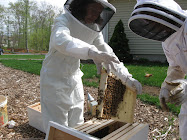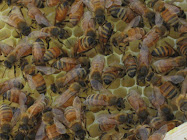
How is everyone? Did you know that you can respond to the blog right at the end of each day's entry? Let me know what you think!
Here is the PHOTO of my nutty parents dressed as Roman Soldiers and their nutty daughter ... me ... dressed as Freida Khalo for Halloween that I'd promised to show you! What fun! And what a hoot!
GREEN TEA
I guess I'm the last to know .... But, just in case I'm not the LAST one ...
Did you know that when you make Green Tea, you are not supposed to steep it in boiling water? You should let the boiling water cool just a bit (or use before it boils) then pour over the tea. Steeping Green Tea in boiling water makes it very BITTER. I learned this over our vacation from my mother. My sister-in-law Tanya jumped in and explained that she'd heard this directly from someone from Asia (Can't remember the exact connection). Then, of course my darling (and handsome) husband jumps in, "Yeah, come to think of that, I've heard of that too!" Wow! And, when you look on the directions on the box, (who looks at the "how to brew tea" directions?? Not me, obviously) sure enough it says "To avoid bitter taste, steep for 2 to 3 minutes in hot, not boiling water". To give myself a little credit, my Yogi Green Tea comments on the water temperature, my TAZO tea does not.
ELECTRIC BILL
Finally, the results are in ...
We have a full months worth of data. Here is what we changed. We started LINE DRYING our laundry instead of using the dryer. We probably dry 2 loads a week in the dryer. I replaced six of our light bulbs with the newer, more efficient CFL light bulbs (more on that later). We tried to chip away at our ghost electricity, like making sure ALL of our television "stuff" was turned off completely, same with the computer, printer and the monitor. Then, of course, trying to make sure we turn off lights if we are not in the room. We DID do outdoor / indoor Christmas lights this year, however, I did NOT put my typical electric candles (8 of them) in each of my front windows. Last year for the same period we used 1058 KWH. This year we used 786 KWH. Wow! That's a big improvement, eh?? Exciting.
OK, CFL Light Bulbs ...
Has anyone else been asking themselves about the mercury levels in the CFL bulbs? When I heard about the recent energy bill that passed, I was dismayed thinking about what else besides fish we were going to contaminate with mercury when we all switch to CFL bulbs by law. After chats with my sister-in-law Tanya and cousin Dave, I checked it out. Here's the gist ...
Incandescent light bulbs are only 5% efficient. Not good. "Replacing incandescent bulbs with compact fluorescents saves energy as you are replacing a 100-watt bulb with one that is only 23-watts, while still producing the same amount of light. In addition, the CFL bulbs produce 70 percent less heat, lowering the need for air conditioning. A CFL bulb will typically last ten times as long as a traditional incandescent bulb, saving you $30 or more over the life of each bulb." But, what about the mercury? A CFL contains 2.4mg of mercury. A power plant releases 10mg of mercury to create the electricity to run an incandescent bulb. So, a CFL will ultimately release less mercury than the incandescent bulb. The important part about the CFL, is to dispose of it properly. To be perfectly honest, it scares me to think of trusting the general American public to do a responsible job with this. But, anyway, Tanya had reported to me that a friend of theirs had a CFL spontaneously explode in their house. On a web site I read a response by Helen Suh MacIntosh, a professor in environmental health at Harvard University, regarding the danger level of a broken / exploded CFL in your home.
Here is what she said:
"These toxic effects are why any mercury spill should be handled carefully, including one that results from a CFL breaking. Having said this, careful handling does not mean that expensive or complicated clean-up of the spill is needed or that you should be worried about you or your family's health, if a CFL were to break in your home. This is because CFLs contain relatively small amounts of mercury -- EPA estimates this amount to be 4-5 milligrams (mg) in a typical CFL. A spill of this amount of mercury is not likely to present any excess risk to you or your family. A quick back-of-the-envelope calculation shows why. [Note: This example is meant only as a quick and dirty example. It is not intended to represent every case nor every situation.] For example, we could imagine the following scenario:
A CFL containing 5 mg of mercury breaks in your child’s bedroom that has a volume of about 25 m3 (which corresponds to a medium sized bedroom). The entire 5 mg of mercury vaporizes immediately (an unlikely occurrence), resulting in an airborne mercury concentration in this room of 0.2 mg/m3. This concentration will decrease with time, as air in the room leaves and is replaced by air from outside or from a different room. As a result, concentrations of mercury in the room will likely approach zero after about an hour or so.
Under these relatively conservative assumptions, this level and duration of mercury exposure is not likely to be dangerous, as it is lower than the US Occupational Safety and Health Administration (OSHA) standard of 0.05 mg/m3 of metallic mercury vapor averaged over eight hours. [To equate these values, we could estimate the average indoor airborne mercury concentration for 8 hours, beginning post-spill at an estimated starting value of 0.2 mg/m3 and decreasing from there. If one assumes the the air exchanges completely in one hour (a fairly standard assumption), then the 8-hour average concentration would be 0.025 mg/m3.] "
A CFL containing 5 mg of mercury breaks in your child’s bedroom that has a volume of about 25 m3 (which corresponds to a medium sized bedroom). The entire 5 mg of mercury vaporizes immediately (an unlikely occurrence), resulting in an airborne mercury concentration in this room of 0.2 mg/m3. This concentration will decrease with time, as air in the room leaves and is replaced by air from outside or from a different room. As a result, concentrations of mercury in the room will likely approach zero after about an hour or so.
Under these relatively conservative assumptions, this level and duration of mercury exposure is not likely to be dangerous, as it is lower than the US Occupational Safety and Health Administration (OSHA) standard of 0.05 mg/m3 of metallic mercury vapor averaged over eight hours. [To equate these values, we could estimate the average indoor airborne mercury concentration for 8 hours, beginning post-spill at an estimated starting value of 0.2 mg/m3 and decreasing from there. If one assumes the the air exchanges completely in one hour (a fairly standard assumption), then the 8-hour average concentration would be 0.025 mg/m3.] "
Ms. MacIntosh goes on to explain how to handle a broken CFL ....
"Even though mercury from the broken CFL is not likely to be dangerous, it would be wise to take extra precautions to minimize mercury exposures. The US EPA publishes guidelines about the specific steps that you should take to clean up mercury in the event that a CFL breaks in your home. Briefly, EPA recommends that (1) you immediately open windows to reduce mercury concentrations inside your home; (2) you do not touch the spilled mercury; (3) you clean up the broken CFL glass carefully and immediately (but not with your hands or a vacuum cleaner), and (4) you wipe the affected area with a paper towel to remove all glass fragments and mercury. EPA further recommends that you place the paper towel and glass fragments in a sealed plastic bag and bring the sealed bag to your local Household Hazardous Waste (HHW)Collection Site."
This link is helpful: http://www.treehugger.com/
LOW MERCURY BULBS: Philip's ALTO bulbs offer mercury content only 13 to 25 percent of typical fluorescent bulbs without sacrificing longevity or performance. Several other manufacturers are now offering low mercury bulbs as well.
Hope this hasn't been incredibly boring, but it's been something weighing on my mind and I thought I'd pass it along.
Enjoy! Stay tuned ... I've got some great family recipes to pass along after our Christmas Vacation. (WHO KNEW my mother used to make chocolate eclairs regularly! I still have to get that one Mom!)






























No comments:
Post a Comment